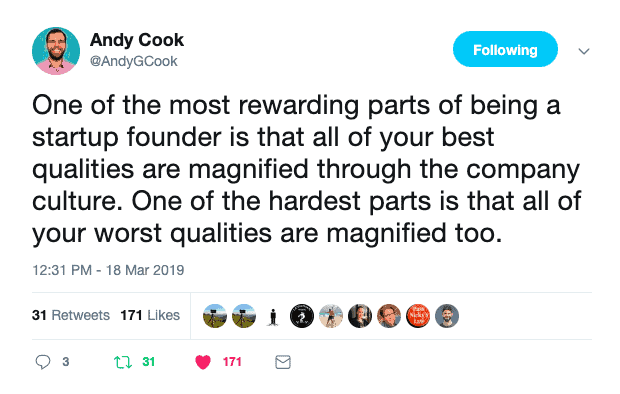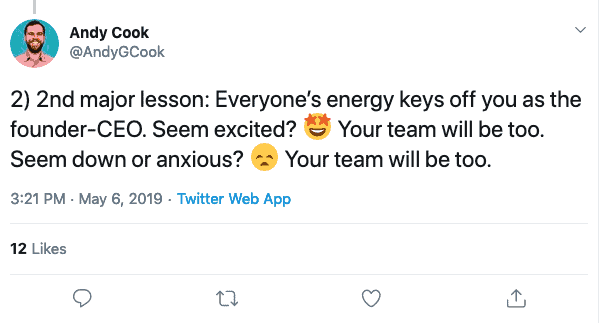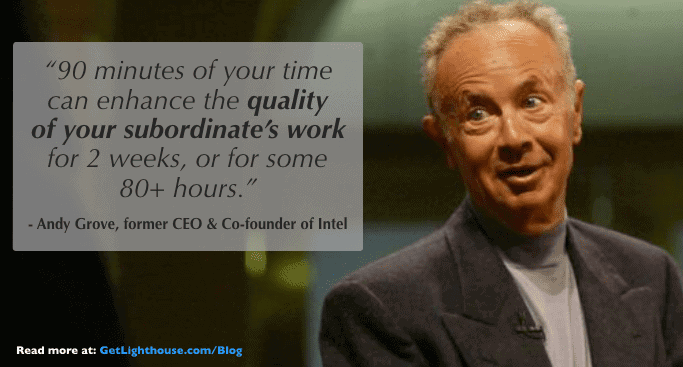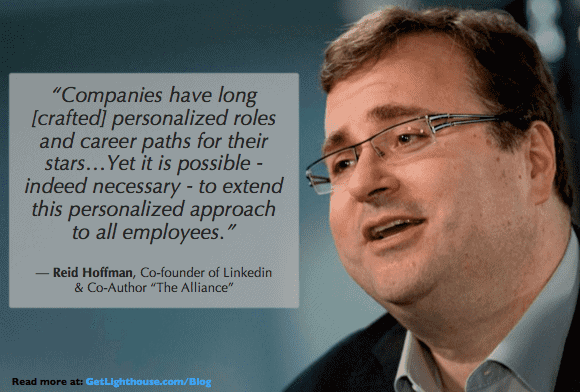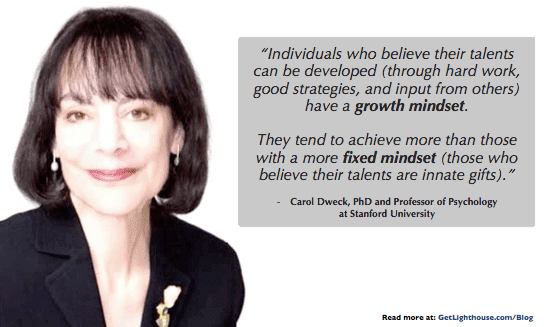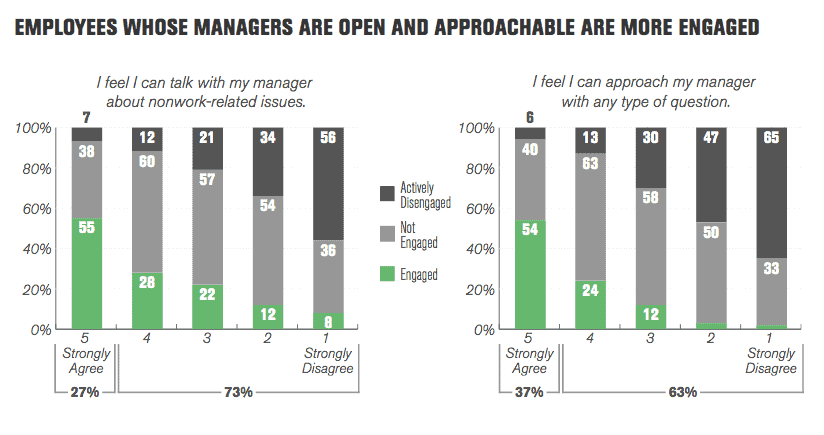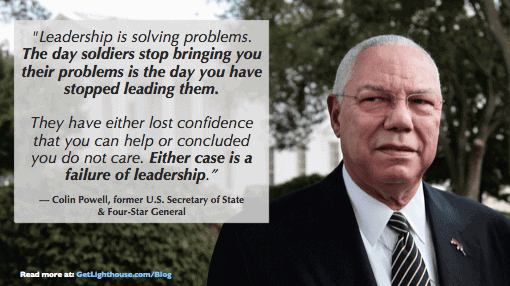What's your company culture like?
Are your employees happy? Are they engaged? Do they feel appreciated? Or is your team built on a weak, crumbling foundation, barely holding together a team with low morale?
It's common for founders to, intentionally or not, wreck their own company culture. The hard part is they often don't even realize there's a problem until it's too late.
In his book, Start With Why, Simon Sinek draws an important distinction many founders never fully understand:
"Your company doesn't have a culture. It is a culture.”
Culture is the offspring of the actions and behaviors of the leaders of that group. This means that it all starts with you, the founder.
Unfortunately, it's not something you can install or implement. You already have a company culture, whether you like what that culture looks like now or not.
The good news is: you can change it. And if you want a great company culture, there's only one place to look.
https://twitter.com/mitchellharper/status/874039004861263873
It starts with you.
As founder, it's your job to lead by example. Molly Graham, former Culture Manager for Facebook, echoed this in an interview with First Round:
"Companies tend to reflect everything about them — their personality, strengths, weaknesses. So when you start defining culture in an intentional way, first look at yourselves.[…]
If a founder is competitive, the company will be more aggressive and competitive. If they are analytical and data-driven, the company will tend to make metrics-based decisions.”
Many founders don't realize that their culture is largely the result of their own actions. Your personal strengths will be made into strengths of the company and so will your weaknesses.
Beyond those obvious strengths and weaknesses, though, are a set of foundational habits that all great founders should seek to develop. They're the real building blocks a great company culture.
5 Ways Founders Wreck Their Company Culture (and How to Create a Great Company Culture Instead)
Joe Gebbia, co-founder of Airbnb, recalled at a recent Y Combinator event how he learned an important lesson from Zappos CEO Tony Hsieh: culture is like concrete. (15:50 mark)
In the beginning, your company's culture can be shaped and molded. However, with time your culture cements. Once enough time goes by, it becomes much more difficult to change it without radical action.
When David Sacks was brought in as the temporary CEO of Zenefits to save it from its law-evading founder, Conrad Parker, he did what was necessary to fix the problems plaguing the company. That involved over 400 layoffs (45% of its employees at the time) and banning company customs such as office parties, beer, and even celebrating with shots when a new contract was ever signed.
Even with all those changes, it remains to be seen if Zenefits fulfills their early hype and promise.
Avoid being the next cautionary tale.
Hopefully, your company is nowhere near in need of those kinds of extreme steps Zenefits had to take. That doesn't mean you're problem free, or there won't be organizational problems in the future if changes aren't made now.
The typical ways that founders tend to wreck their company culture are easy to miss, often leading you to assume everything is fine– until it's not.
In our 5+ years of helping managers and leaders, we've noticed a number of patterns that lead to founders wrecking their cultures even when they have the best of intentions.
Fortunately, if you catch these mistakes early, you can create a great company culture in its place. Here's those mistakes to avoid and what to do instead.
Mistake #1: Not making 1-on-1s a habit
Investor, advisor, and Gladly co-founder Michael Wolfe says that 1-on-1s are a critical part of the "operating system” of a company:
"Many founders look at me quizzically when I explain to them that regular 1–1's with employees are a startup's best friend.
They can facilitate a culture that moves quickly, makes faster and better decisions, and minimizes meetings and formal processes.”
Regular 1-on-1s are the bedrock of a strong company culture. They're ground-zero for:
- Establishing trust
- Building rapport
- Implementing growth plans
- Obtaining and giving feedback
- And working through issues
Each of these are necessary elements of a healthy culture and a well-run company in general. Yet, many founders don't make the time to invest in regular 1-on-1s with their team. They don't see the value in sitting down with each individual team member and can't justify the 30-60 minutes every 1-2 weeks it takes to have them.
"You don't have time for 1-on-1s. This is true. The thing is, you also don't not have time,” says investor, serial entrepreneur, and Saastr founder, Jason Lemkin. "There isn't a better investment you can make in your VPs than meeting either once a week, or at least, once every 2 weeks.”
The cost of not having regular 1-on-1s
Regular 1-on-1s are so important that Ben Horowitz, author of The Hard Thing About Hard Things, says he nearly fired a manager and his manager for not having regular 1-on-1s:
Without regular 1-on-1s:
- Communication and trust falls apart (or is never built in the first place)
- No one comes to you with their issues (so you don't find out there's a problem until a third of your team has decided to leave)
- Growth and improvements stall for lack of regular feedback
It's impossible to maintain the trust and satisfaction of your team as the company grows without regular 1-on-1s, leading to a growing strain on everyone in the team until something (or someones) break under the strain.
What to do instead: Establish regular 1-on-1s
Whether you have 1-on-1s on a weekly or (at least) bi-weekly basis, you should at least be meeting with every one of your direct reports regularly.
How long your 1-on-1s are is completely up to you. Some prefer 30 minutes, while former Intel CEO and co-founder Andy Grove suggests a minimum of one hour each sit down to really get to dig in to your team member's issues.
Here are some tips for having constructive, regular 1-on-1s:
- Never cancel your 1-on-1s: Showing your employee that time with them is important to you helps build trust. Breaking this trust makes it more difficult to keep future one on ones constructive. If you have an emergency come up, reschedule instead.
- Ask some great questions: Questions are great for building rapport, learning from your team, and uncovering issues to address. They're a great jumping-off point for digging into the real problems below the surface that they may not be willing to open up about unprompted.
- Take action after the meeting (bridge the gap): Your work doesn't end when the meeting does. Take those action items you discussed and communicate with your employee to show them that you're serious about helping them. Create a bridge from your last meeting to the next so there's a real sense of progress.
Further reading to learn more about how to have effective 1-on-1 meetings:
- 7 Essential Tips for Effective 1 on 1 Meetings with Your Manager
- One on One Meetings: The Only Guide Managers Need [Free Template]
Mistake #2: Not growing your people
Coaching legend Lou Holtz said, "In this world, you're either growing or you're dying.” This is true in companies as much as it is in life.
Saastr founder Jason Lemkin says you need to create a growth plan for your best people when he wrote:
"They join a start-up to grow, to learn, to do new things. If they can't grow, they die a little every day.
It's your job to understand the career path for at least your first 50 employees. Know it. And do whatever you can, within the boundaries of reality, to help them achieve it.”
If you don't take the time to set up growth plans for your team members, their motivation to come to the office each day dwindles until they begin to look to greener pastures for the opportunity to grow.
After a certain point, it'll be too late and there will be nothing you'll be able to do to win them back as Peggy in Mad Men surprised her boss:
What to do instead: Create an alliance with each of your employees
It's easy to make the mistake of looking at each of your employees as strictly someone who is doing something today for you and the company.
However, in his book, The Alliance, LinkedIn co-founder Reid Hoffman and co-authors Ben Casnocha and Chris Yeh suggest shifting this view to one where the benefit is a mutual alliance:
"Every employee relationship should be bidirectional in nature; it should be clear how the employee benefits and how the employer benefits.”
Instead of just seeing each employee as someone who does work for the company in exchange for a salary, see the relationship as an alliance where:
- You're providing them with the opportunity to grow, learn, and improve, and
- They're providing you with the fruits of that effort
Implement "Tours of Duty”
Hoffman, Casnocha and Yeh suggest what they call a "Tour of Duty.” To implement a tour, you (or their manager) and your team member agree on a length of time along with goals to accomplish during that period of time in tandem with their core responsibilities.
With this kind of mutual agreement in place, your people not only have a clear set of goals and expectations in place to follow but:
- A way to track their progress
- Greater commitment from them as an employee, and
- Motivation to come to work to make progress toward those goals because they align with what they want.
Hoffman also says the end of a tour often results in those employees wanting to establish a new tour, as they become eager to set new goals and work to accomplish them; the end of one tour is often the beginning of another with your company.
Best of all, the excitement to come into work coming from career alignment with them is infectious. It not only keeps them engaged in the work they're doing, but it helps establish a culture where growth is not only valued, but clearly defined.
Whether you test out implementing tours or simply work on establishing your own growth plans with your employees, invest in your people by helping them grow. When you do, you'll be building a culture that's stronger and healthier for it.
Further reading on implementing employee growth plans:
- The 3 Questions Every Manager Struggles with Making Career Development Plans
- Employee Development Plans: The Competitive Edge to Winning the World Series and Helping Your Team Thrive
- Employee growth often starts being important when you have about 25 employees, which is part of the reason everything breaks at 25 employees.
Mistake #3: Setting a poor example
It's a sometimes frustrating fact of human behavior that those who follow us learn from our actions and behavior more than our words. The same is true for your team.
As a founder, you need to lead by example. Your employees will emulate your behavior, both good and bad, whether you like it or not.
Brian Chesky, co-founder of Airbnb, put it best when he said: (14:20 mark above)
"Founders are like parents and the company is a child. And a child will manifest in many ways behaviors that parents have between their relationship.
If the parents are dysfunctional, they're not working together. Then the child's gonna be, frankly, pretty ****ed up.”
If you're trying to streamline communication, you need to become a better communicator. If you consistently lack good communication with your team by jumping to conclusions and sending curt messages, they'll take the cue and follow those habits. The result: your organization has bad communication.
Similarly, If you're late to the office, talk bad about clients or customers, don't respect people's time by missing appointments, your team will emulate that behavior.
You are the model of your company's culture– everything starts with you, whether good or bad.
What to do instead: Lead by example
Author and speaker Tom Peters, in quoting an old consultant he worked with, says that for leaders like you, "It's always showtime."
Your actions have to match the message you're giving to your team. They're always watching, whether you know it or not.
Reinforcing this, in his leadership classic, High Output Management, former Intel co-founder Andy Grove wrote:
"While we move about, doing our jobs, we are role models for people in our organization – our subordinates, our peers, and even our supervisors…
Values and behavioral norms are simply not transmitted easily by talk or memo, but are conveyed very effectively by doing and doing visibly."
While it can be challenging, raising your self-awareness as a leader is huge. How you act will largely determine your company's culture.
- If you want your culture to be growth-centric, your team needs to see you invest in your own growth and development, as well as being willing to invest in theirs. Do that and they'll be encouraged to do the same (if they haven't already).
- If you want your culture to be free-thinking and creative, you need to give your people the space to innovate and not look over their shoulder constantly. Showing you take time to think about the big picture and explore ideas, will also help them do the same.
- If you want your company's culture centered partly around accountability and self-management, you need to show your team that you fulfill your personal goals and follow through on your commitments. If your team sees you consistently slipping on deadlines and not sharing what you're doing, they'll find little motivation to do anything differently.
Whatever values you want your culture to be centered around, it's critical to remember that your example will be the guiding force that dictates what direction your culture goes in.
Further reading on leading by example:
- The One Key to Building and Keeping a Great Company Culture
- Developing your self awareness is one of the most important skills to master as a leader and manager.
- Positivity and praise makes work more fun and creates a healthy culture.
Mistake #4: Promoting the wrong people
The Valley has a checkered history of promoting bad managers and lionizing leaders for the wrong reasons. This is damaging for several reasons, most notably because people leave managers, not companies.
Things could be going great in the beginning, but as soon as you promote your first managers, problems arise. If they became managers for the wrong reasons, or lack the training and support to handle the job, you will likely have problems with bad management.
Over time, those problems can snowball, leading to an unexpected wave of turnover that, by that point, is impossible to stop.
Signs that someone is a bad manager include:
- They'd rather focus on IC work: One of the most important aspects of being a good manager is learning to shift from being an individual contributor to having a multiplier mindset. If one of your managers spends most of their time on IC work and doesn't invest in supporting and listening to their team, it will end poorly for everyone.
- They don't like working with others: If someone is consistently reluctant to work with others and would rather board themselves up in their office, they're going to be a bad manager. Being a manager requires that you work with your team regularly, and that requires constant communication.
- They don't have a growth mindset: People without a growth mindset aren't willing to invest in their own growth and development because they believe their knowledge and ability is fixed. As a manager, it's critical that you invest in constant growth and development, because being a manager is often completely different from their past work. If a manager of yours doesn't see the value in investing in their own growth, they'll never be a good manager who grows their people either.
A manager without the willingness to shift to a multiplier mindset, work with others regularly, and adopt a growth mindset is a manager destined to fail. And every manager who suffers from even one of those qualities can cause serious damage to your organization, from turnover to low team engagement.
What to do instead: Look for these qualities in a good leader
Instead of promoting based on individual contributions, look for these qualities of a good leader in your people to identify those employees who would be a good fit for management:
- They care about their teammates: Empathy is an important part of being a good manager. Empathy is what makes us care– and want to help– those around us. A good manager is not just sympathetic to their team member's challenges, but wants to help them overcome those challenges. This is one of the most important elements of an engaged team as Gallup discovered:
- They're good listeners: Good managers are good listeners. Managers need to not only dig for feedback and listen to their team member's challenges, but be willing to listen to their employee's feedback as well.
- They're accountable: Someone who has the promise to be a good manager is committed to their work and accountable to both themselves and their manager. Do you want an entire team that acts like the person you're promoting? If not, don't make them a manager.
- They invest in their own growth: A growth mindset is one of the most important qualities to look for in a good leader. Look to identify employees who show interest in developing new skills, and who follow through on those objectives.
Promote from within
Beyond looking for the right qualities in a potential manager, it's also important to consider the impact of promoting from within vs. hiring in leaders.
The strength of your culture is determined, in part, by how long your best people have been with your company. By promoting from within, you're able to hold onto your best employees longer and preserve your early culture longer.
Those employees who have been with you for a while know what the company is about. They have seen your example, and know key moments in your company's history that explain why you do things a certain way.
As you grow and you're no longer able to filter everyone that comes into your company, those key people will be able to help maintain the culture you established together in the early days of the company. They'll keep certain values going, and be strong examples of the people you want in your company.
Finally, who you promote signals to your whole company what you want to see more of. These people are getting a title, salary, and potential equity boost after all. Realize that anyone who didn't get promoted is going to try to emulate the behaviors of those who did.
Further reading on promoting from within:
- Benefits of promoting from within.
- Make sure you don't make these common mistakes when promoting from within.
- Look for these qualities in who you promote.
- Work in Silicon Valley? Break the cycle of bad managers.
Mistake #5: Not listening to your people
The bigger your company gets, the more you won't know. You can't be everywhere. Meetings will happen, deals will close, customers will churn, and employees will talk, all without you around.
Without listening to what's going on, building trust, and asking questions to find out how your team is feeling, you'll never know if there's a problem or even what's working.
When you make decisions based solely on your own judgment and opinions and never ask for their feedback, your employees begin to feel like they don't matter. That damages trust, engagement, and motivation.
If you run a survey of your team, you can't just forget about the results and move on without taking action.
Similarly, you can't run 1-on-1s, take your team's feedback, and do nothing with it. Sooner or later, your team will see that you're not really serious about making change, feel like they don't matter to you, and leave. Instead, you'll become a Dilbert cartoon punchline.
What to do instead: Make listening a key part of your management culture
We've already talked about the importance of regular 1-on-1s. Your individual 1-on-1s are key to developing a system where you can obtain regular feedback from each team member.
It's important to not just say you're going to listen more, but make it a part of your design. Regular 1-on-1s are the best place to start, but there's more you can do to make sure you're always gathering feedback and gauging what your employees are thinking and feeling.
In an interview with Axcient CEO Justin Moore, First Round asked Moore about the importance of culture and some of the techniques he's used to strengthen his company's culture.
Moore uses regular surveys as a way to benchmark how his employees feel about the organization. "As a leader, this not only gives you a sense of how you're doing, but it also allows employees to feel responsible and to be a part of improving the culture and the company,” says First Round.
Ready to build a great company culture?
At the end of the day, it's your job to lay the foundation for a strong culture. There are many ways that founders wreck their company culture, but they all revolve around the same basic principles. They fail to do these fundamental habits of great company culture:
- Develop strong relationships with their individual team members
- Invest in their team member's growth
- Lead by action and example
- Understand what makes a good manager, so they promote the right people
- Listen to their team member's challenges and feedback and do something about problems and issues
A good manager understands the value of building rapport, gathering feedback, growing their people, and overall being the change they wish to see at their company.
They understand that a company is made up of people, and your people are your culture.
People crave connection, they have goals, challenges (and often have a habit of not talking about them until it's too late), and need your support as their leader to guide them.
As a founder or manager in charge of developing your company's culture, remember that it's about the people that work for you and ultimately making them feel appreciated and happy.
Those happy and grateful employees will then help build your culture into something that is not just positive, but productive as well.
Learn more about building a great company culture:
- The One Key to Building and Keeping a Great Company Culture
- Questions to ask a CEO to ensure a healthy company culture
- How to Change the Culture of Your Team
- Toxic Culture: Why Wells Fargo Created Over 3 Million Fake Accounts and Hurt so many Americans
- 10 Key Quotes from Patty McCord of Netflix in Powerful about Building a Great Culture

